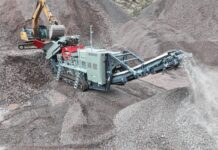
CONSTRUCTION of the Forth Replacement Crossing (FRC) continues, a project with its share of complex and challenging marine work, according to Damian McGettrick, an engineer with WM Plant Hire. The site is currently home to some gigantic cranes and excavation equipment.
A key to the project is the construction of the bridge foundation, which includes both caisson and cofferdam structures. These had to be cut into the rock to ensure the bridge has a firm footing in the Forth Estuary. The Forth Crossing Bridge Constructors (FCBC) relied on GPS technology to position the excavation equipment. GPS also helped profile the sea bed, to allow accurate positioning of the three main caissons to support the towers – some of which involved working on beamer rock – and for the prefabricated cofferdam structures on the north and south approaches.
Experienced marine contractor Colcrete von Essen used long reach excavators from WM Plant Hire mounted on its self-propelled barge Sophie (flanked by spud barges “Köster“ and “Feierförde”). The barge was fitted with underwater breakers and rock milling attachments. A GPS computer system communicated with sensors on the machine bucket and arm, helping pinpoint their position within a 3D model.
This model was built up using the existing sea bed survey and the design drawing showing what had to be excavated to achieve the finished profile. The computer recorded the material excavated, taking account of the changing tide, and communicated to site base stations via a radio link. The excavated material was taken away on split hopper barges by tug to the offshore dumping ground.
The operators had to rely on the information displayed on a 20in monitor in the cab. In addition there were the physical demands of weather and tides to contend with, working the machines 24/7 over the course of the project – “a truly remarkable achievement” said McGettrick.
Construction of the £790m bridge began in 2011 and is due to finish in 2016.








